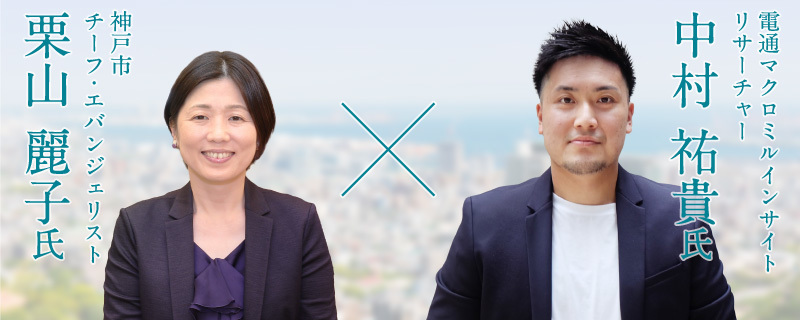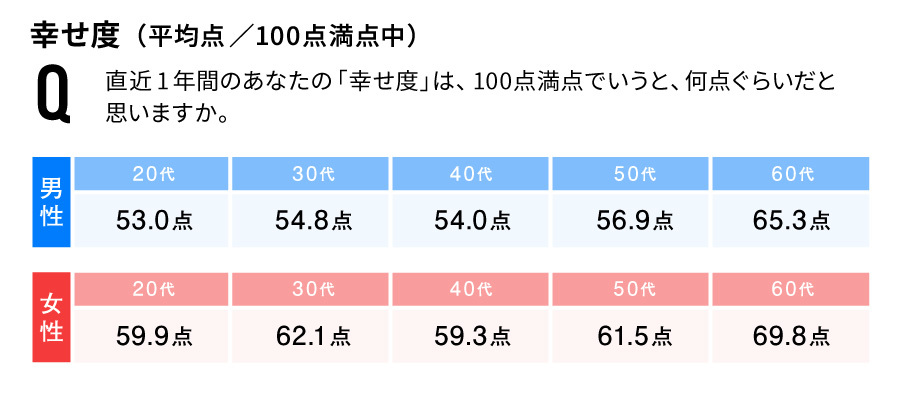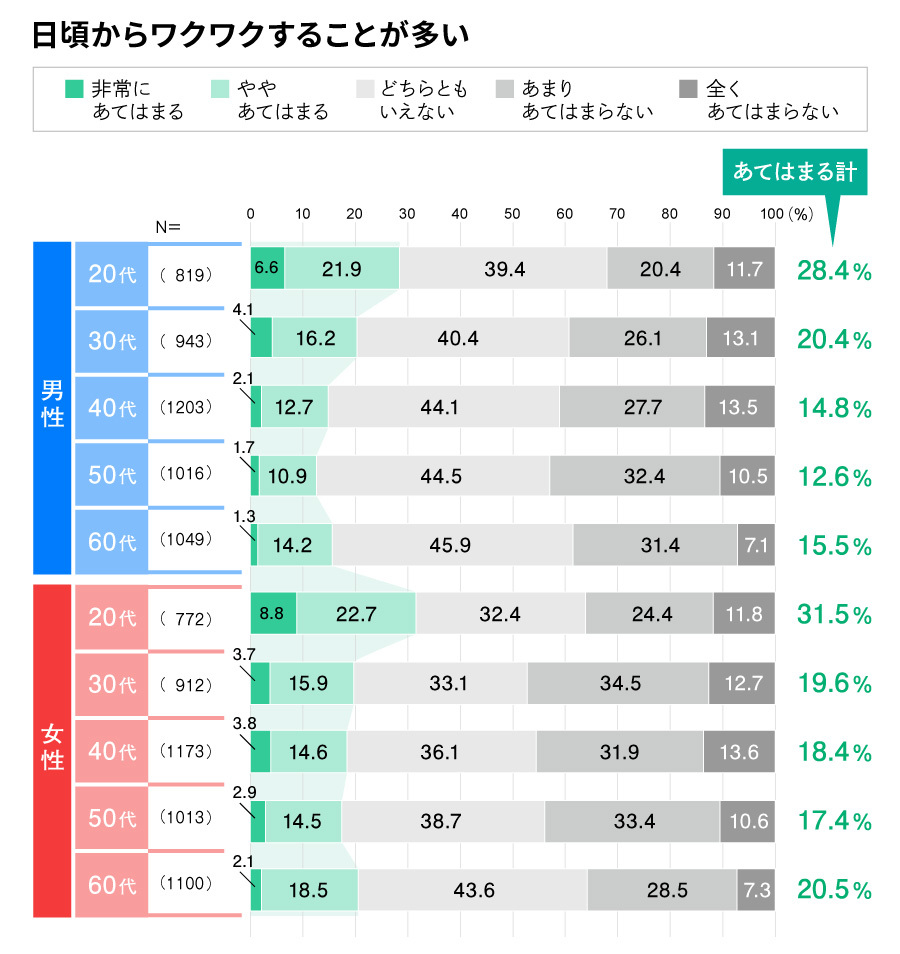This project examines the results of the "Wellness 10,000 Survey" and explores new trends in healthcare through discussions with experts. The theme this time is "Public-Private Collaborative Healthcare."
Solving healthcare challenges requires deeply engaging with people's lives and working alongside them over the medium to long term. This often necessitates collaboration between local governments and private companies, leading to various initiatives nationwide. Kobe City in Hyogo Prefecture is one such city advancing a series of pioneering initiatives through corporate partnerships.
For this installment, we welcomed Reiko Kuriyama, Chief Evangelist at Kobe City Hall who promotes Kobe's appeal in the Tokyo metropolitan area, as our guest. Yuki Nakamura from the Dentsu Inc. Healthcare Team interviewed her about the keys to realizing public-private co-creation in healthcare.

Kobe City's Appeal: Connecting with Residents' Needs During the Pandemic
Nakamura: In recent years, we increasingly hear keywords like "growing health consciousness," "urban exodus," and "diversifying life and work values." As someone responsible for promoting Kobe City in the Tokyo metropolitan area, do you sense shifts in awareness among urban residents you interact with?
Kuriyama: Recently, I've had more opportunities to be interviewed on the theme of leaving urban centers, and I do feel an increase in people considering moving to regional areas. Wellness, which has gained global attention lately, encompasses not just physical health but mental well-being too. From that perspective, "whether a place makes me feel happy" is becoming an important factor in choosing where to live.
Nakamura: Our latest "Wellness Survey of 10,000 People" went beyond physical health to include extensive wellness-focused questions. For example, here are the results when respondents self-rated their "happiness level." I feel there's a link between the balance people seek during the pandemic – "urban convenience versus healing from nature" – and Kobe City's appeal.

*Rounded to the nearest hundredth
Kuriyama: I believe Kobe City's appeal lies in how it packs together the best aspects of both the city and nature. The central area around Sannomiya is an historic port town with an urban feel, yet just north lies Mount Rokko and to the south the Seto Inland Sea, keeping nature constantly close. Furthermore, within about a 30-minute drive, you can access satoyama areas reminiscent of old Japan, with rice paddies and fields. I'm not originally from Kobe, but I've also come to appreciate its culture of welcoming outsiders and embracing diversity. That, too, is part of Kobe's charm.
Nakamura: When people hear "Kobe," they often think of tourist spots and gourmet food, but it's actually a place with a great balance for living a happy life.
Kuriyama: Of course, the traditional tourist spots, gourmet food, and urban image are part of its appeal. But it's also a city that can simultaneously meet the needs of people from the metropolitan area seeking nature and relaxation. To age well, an environment that allows for healthy living, both physically and mentally, is essential. I believe regional revitalization and wellness are inseparable.
Preventing Social Isolation Among Senior Men Through Bread Making!?
Nakamura: Kobe City is also known as a medical industry hub, advancing pioneering projects across various fields in healthcare—like the Kobe Model for Dementia—to solve local challenges. From a pandemic healthcare perspective, what initiatives are you focusing on?
Kuriyama: Previously, I worked in the healthcare division of a private food manufacturer. Even then, frailty—a state of diminished physical strength, cognitive function, and social connections due to aging—was recognized as a social issue.
There were concerns that the prolonged stay-at-home requests during the pandemic would further exacerbate frailty issues. Kobe City has actually collected data confirming this, and we take the scale of this problem very seriously.
(Survey results: https://www.city.kobe.lg.jp/a46210/press/202108031320001.html )
Kobe City foresaw this situation early in the pandemic and planned a frailty prevention initiative called "KOBE Genki! Ikiiki!! Exercise." It is currently being broadcast on television and has been well-received. While we now live in an era where people can watch videos anytime on YouTube, having the program air at a fixed time daily on TV seems to make it easier for older adults to establish a routine.
While digitalization is gaining attention, selecting approaches tailored to the target age group and objectives is crucial. At the same time, Kobe City is also conducting pilot tests for frailty prevention projects using digital technology in collaboration with startups. This multifaceted exploration of more effective approaches is perhaps characteristic of Kobe City.
Nakamura: Regarding frailty, we recognize it's influenced not only by physical decline but also by mental health aspects like social connections and environment. The "Wellness 10,000 Survey" found, for example, that men in their 40s to 60s experience fewer "exciting things in daily life" compared to other age groups.

*Percentage composition (%) is rounded to the second decimal place, so the simple sum of the percentages may not always match.
Kuriyama: That's right. Kobe City also has a project designed specifically with senior men's wellness in mind. It's a community activity known as "Pan-ji," an initiative to help senior men maintain social connections. Senior men who learned bread-making from Kobe bakers—the "Pan-ji"—showcase their skills at local community cafes and events. The goal is for them to develop hobbies and skills they're passionate about while increasing opportunities to engage with the community. We believe having a sense of belonging in the community significantly impacts a person's happiness.
Nakamura: That's a very interesting initiative. Is it run by Kobe City?
Kuriyama: It's operated as part of the activities at the "Design Creative Center Kobe" (nickname: KIITO), commissioned to a private company (designated manager). KIITO proposes ways for both adults and children to learn, create new connections, and live more enriching lives through events, exhibitions, and workshops related to design and art.
Kobe City promotes itself as an "experimental city," collaborating not only with private companies but also with various organizations and groups to encourage new challenges. Underlying this is a wellness perspective: "Learning new things and building connections with people leads to fulfillment and happiness."
Local governments are also seeking private sector expertise to take on new challenges.
Nakamura: In recent years, coupled with the spread of SDGs, I feel more companies are showing interest in the healthcare field. Collaboration with local governments is essential to tackle regional health challenges, but from a corporate perspective, such partnerships often feel like a high hurdle.
Kuriyama: When I was in the private sector, even if I wanted to collaborate with a municipality, I often hesitated to take that next step, thinking, "Who should I even talk to about this?" or "They'll probably just turn me down anyway..." But after actually becoming a municipal employee, I realized that surprisingly many municipalities are proactive about new challenges and collaborating with the private sector. Municipalities are seeking private sector expertise too. So, I encourage you to reach out and consult with any department, regardless of which one it is.
Nakamura: Among local governments, Kobe City seems particularly proactive in pioneering initiatives. Why do you think that is?
Kuriyama: Personally, I feel Kobe City itself has a culture of embracing new challenges. Furthermore, Mayor Hisamoto looks toward the future not just from a Kobe perspective but with a global vision. This fosters a mindset among staff members to embrace challenges rather than play it safe.
Nakamura: You've also been quick to embrace public-private co-creation, haven't you?
Kuriyama: It's true that local governments can struggle with new initiatives or find them difficult to advance, so collaboration with private companies is essential. Kobe City engages in various public-private partnerships, one being "Urban Innovation Kobe" (UIK). This co-creation project brings together city officials and businesses to solve municipal challenges while fostering corporate growth. Starting in Kobe, this initiative has now expanded nationwide as "Urban Innovation Japan" (UIJ).
Nakamura: What do you focus on to ensure effective co-creation between private companies, which pursue profit, and local governments, which prioritize fairness and community contribution?
Kuriyama: It's common for projects to evolve beyond their initial vision as they progress. Even so, I believe it's crucial for both sides to maintain a clear focus on "the purpose behind the project." When many stakeholders are involved, establishing a control center (point of contact) is also important. And while it may seem obvious, I feel the key to progressing smoothly and achieving results lies in both the company and the municipality respecting each other and constantly striving for a win-win relationship.
Nakamura: I see, that's very insightful. But with so many projects underway, it must be challenging for a single municipality to maintain a unified direction, right?
Kuriyama: Kobe City formulates a vision every five years, outlining the city's ideal state and future goals. Currently, all projects operate based on the "Kobe 2025 Vision," so there's no significant deviation in direction. However, as you mentioned, Kobe is a large municipality, and honestly, it's difficult to comprehensively grasp every activity across all departments. It's probably even harder to understand from an outside perspective.
This is where the activities of promotion teams like ours become crucial. We believe it's essential to match the information our target audience seeks with the information Kobe City wants to present, and then communicate that information not as scattered "points" but as a cohesive "surface" to effectively reach our targets.
Nakamura: Considering the healthcare and wellness perspective, it seems like there are broad challenges we should tackle. Are there any themes you particularly want to focus on going forward?
Kuriyama: Even within the wellness perspective, what people seek varies greatly. For example, whether someone has children or not can completely change the environment they require, even among people of the same gender and age. So, we always consciously avoid promoting the same thing uniformly and instead tailor our initiatives to the target audience. Furthermore, as we move toward an era of longer working lives, I sense more people are rethinking their work styles. We want to keep challenging ourselves with initiatives like promoting side hustles and workation programs, which we started last year, to expand the appeal of working in Kobe and explore new possibilities for work styles.
As a new initiative, we're also focusing on the SNS promotion "Tsubuyakobe," which launched last winter. Aiming to connect the Tokyo metropolitan area with Kobe, we're involving private companies and using "two-way" communication on Twitter, Instagram, and other platforms to deliver information that resonates with our target audience. This is actually an experimental effort, and we plan to announce the results in October. Going forward, we also want to use this mechanism to communicate Kobe's appeal in relation to wellness and healthcare.
Nakamura: Incorporating the insights on public-private collaboration you shared today, our healthcare team also intends to tackle healthcare challenges together with private companies and local governments.
[Concluding the 4th Dialogue]
Wellness is a crucial theme for future regional revitalization. This discussion reaffirmed the importance of tackling this social challenge fundamentally, not just through local governments but by collaborating with private companies, universities, and research institutions.
As researchers, we aim to contribute by capturing the ever-changing values and lifestyles in society, both to clearly convey the appeal of regions and to support various initiatives that enrich people's lives.
【Survey Overview】
Survey Name: "The 14th Wellness 10,000-Person Survey 2020"
Conducted: November 2020
Survey Method: Online survey
Survey Population: Men and women aged 20 to 60 nationwide (10,000 samples)
*Samples collected to match population distribution (8 categories) by gender, age, and region
Survey Company: Dentsu Macromill Insight, Inc.












